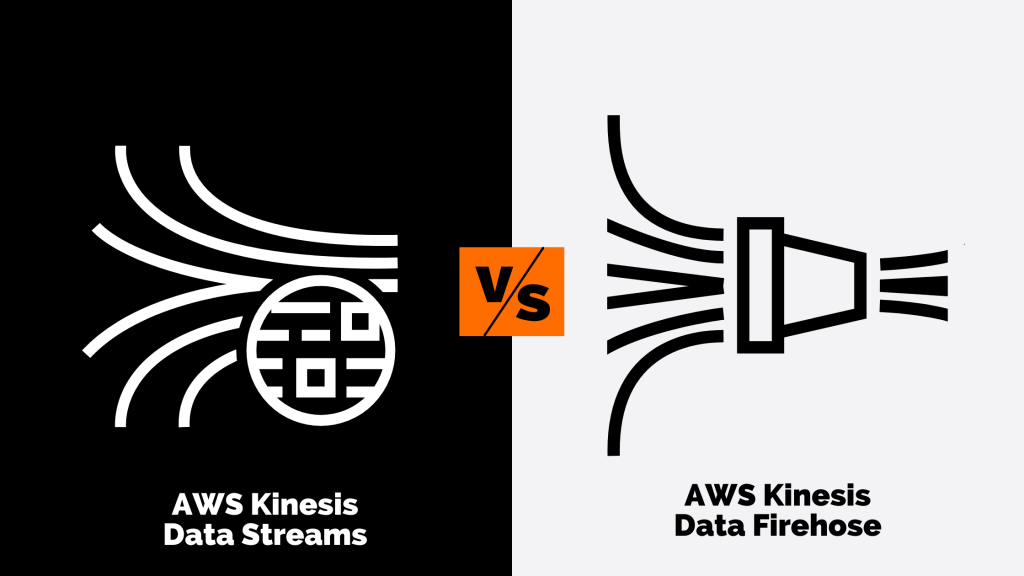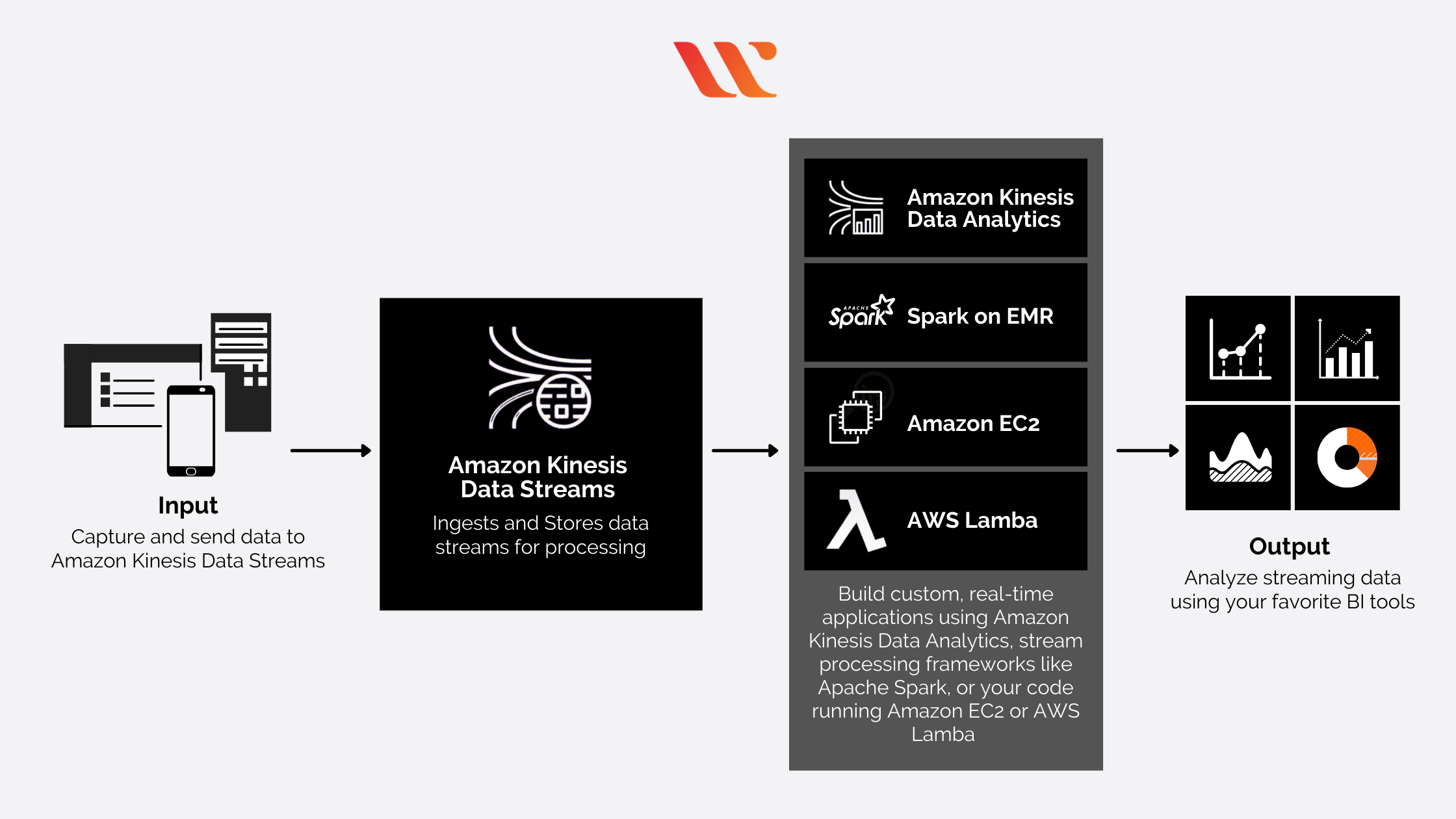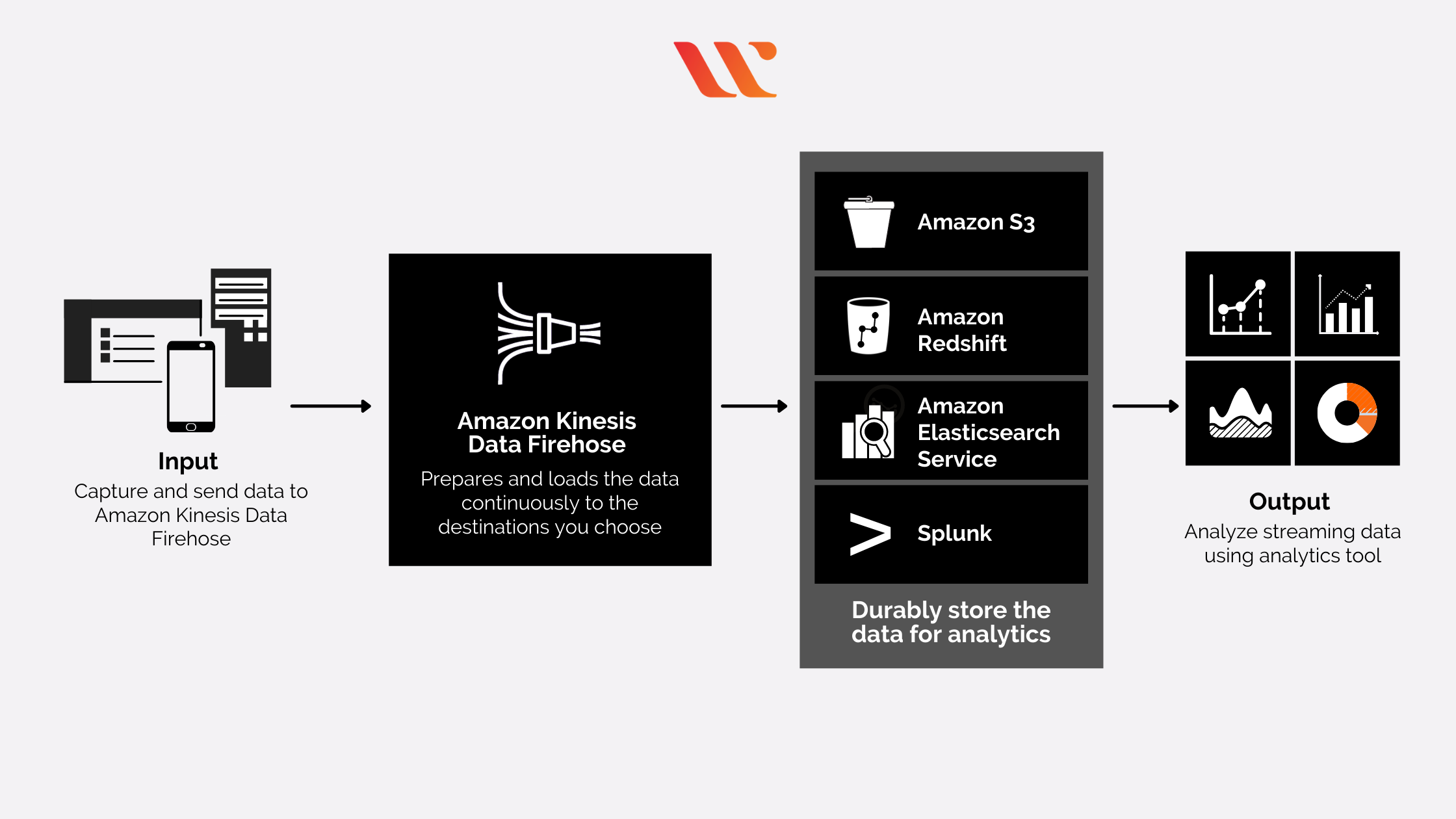AWS Kinesis is the favorable choice for applications that use streaming data. Explore AWS kinesis data streams vs AWS kinesis data firehose right now!
The AWS ecosystem has constantly been expanding with the addition of new offerings alongside new functionalities. Amazon introduced AWS Kinesis as a highly available channel for communication between data producers and data consumers. It serves as a formidable passage for streaming messages between the data producers and data consumers.
Data producers could come from almost any source of data such as social network data, mobile app data, system or weblog data, telemetry from connected IoT devices, financial trading information, and geospatial data.
On the other hand, data consumers would include references to data processing and storage applications such as Amazon Simple Storage Service (S3), Apache Hadoop, ElasticSearch, and Apache Storm.
Users could access different services with Amazon Kinesis, such as Kinesis Video Streams, Amazon Kinesis Data Streams, AWS Kinesis Data Firehose, and Kinesis Data Analytics. The following discussion aims to discuss the differences between Data Streams and Data Firehose.
An Overview of AWS Kinesis
Before discussing the differences between Kinesis data streams and Firehose, it is important to understand Kinesis first. Amazon Kinesis is a significant feature in AWS for easy collection, processing, and analysis of video and data streams in real-time environments.
AWS Kinesis helps in real-time data ingestion with support for data such as video, audio, IoT telemetry data, application logs, analytics applications, website clickstreams, and machine learning applications. It supports effective data processing and analysis with instant response and does not have to wait for collecting all data for starting the processing work.
What are AWS Kinesis Data Streams and Data Firehose?
AWS Kinesis Data Streams and Firehose are the two distinct capabilities of Amazon Kinesis, which empower it for data streaming and analytics. However, the debate between Kinesis Data Streams and Firehose has been one of the prominent points of discussion recently. Let us find out the differences between Amazon Kinesis Data Stream and Firehose to understand their individual significance.
AWS Kinesis Data Streams is the real-time data streaming service in Amazon Kinesis with high scalability and durability. It can help in continuously capturing multiple gigabytes of data every second from multiple sources. The higher customizability with Kinesis Data Streams is also one of the profound highlights.
As a matter of fact, it is the ideal choice for developers involved in developing custom applications or streaming data according to special needs. On the other hand, the benefits of customizability come at the price of manual provisioning and scaling. Generally, data is set up for 24 hours of availability in a stream while also ensuring that users could achieve data availability for almost 7 days.
AWS Kinesis Data Firehose provides the facility of loading data streams into AWS data stores. Kinesis Data Firehose provides the simplest approach for capturing, transforming, and loading data streams into AWS data stores.
The automatic management of scaling in the range of gigabytes per second, along with support for batching, encryption, and compression of streaming data, are also some crucial features in Amazon Kinesis Data Firehose. Firehose also helps in streaming to RedShift, S3, or ElasticSearch service, to copy data for processing by using additional services.
Understanding the Architecture – AWS Kinesis Data Streams vs. Data Firehose
The first point of comparison between the two key capabilities of AWS Kinesis would refer to the architecture. The explanations on architecture of AWS Kinesis Data Streams and Firehose can show how they are different from each other.
Data Streams
In the case of data streams, data producers enter the records into Kinesis data streams or KDS. Then, AWS offers the Kinesis Producer Library or KPL for simplifying producer application development. In addition, it also helps in achieving higher write throughput to a particular Kinesis data stream.
The Kinesis data stream is basically a collection of shards, with each shard featuring a sequence of data records. Data records feature a sequence number, partition key, and a data blob with size of up to 1 MB.
The data blob is generally an immutable sequence of bytes. Consumers could then obtain records from KDS for processing. Subsequently, users can build applications by using AWS Kinesis Data Analytics, Kinesis Client Library, or Kinesis API.
Start preparing for AWS Certified Cloud Practitioner Certifications today with 9+ hours training online training videos and 21+ labs today!
Data Firehose
The operations of Kinesis Data Firehose start with data producers sending records to delivery streams of Firehose. Kinesis Data Firehose delivery stream is the underlying component for operations of Kinesis Firehose. The delivery stream helps in automatically delivering data to the specified destination, such as Splunk, S3, or RedShift.
Users have the option of configuring AWS Kinesis Firehose for transforming data before its delivery. You should activate data transformation on Kinesis Firehose with the creation of your delivery stream. Now, Kinesis Data Firehose can invoke the user’s Lambda function for transforming the incoming source data. It also ensures the delivery of transformed data to all the desired destinations.
Try 3-Full Length Mock Exams with 195 Unique Questions for AWS Certified Data Analytics Certifications here!
Comparison between Amazon Kinesis Data Streams and Data Firehose
Based on the differences in architecture of AWS Kinesis Data Streams and Data Firehose, it is possible to draw comparisons between them on many other fronts. Here are some of the notable pointers for comparing Kinesis Data Streams with Kinesis Data Firehose.
-
Objective
The fundamental objective of the services also plays a crucial role in differentiating data streams vs. Firehose comparison. The basic purpose of the tools can exhibit a profound difference between them. Data Streams is a low latency streaming service in AWS Kinesis with the facility for ingesting at scale. On the other hand, Kinesis Firehose aims to serve as a data transfer service.
The primary purpose of Kinesis Firehose focuses on loading streaming data to Amazon S3, Splunk, ElasticSearch, and RedShift.
-
Provisioning
Provisioning is also an important concern when it comes to differentiating between two technical solutions. Kinesis Data Streams work as a managed service and offer profound levels of flexibility in terms of customization. However, the cost of customization becomes clearly evident with KDS due to the need for manual provisioning.
Users must employ manual configuration for shards to ensure proper provisioning of KDS. On the other hand, Kinesis Data Firehose comes forward as a fully managed service. Therefore, users don’t have to worry about any administrative burden when it comes to using Kinesis Firehose.
-
Data Storage
The effectiveness of data storage is also one of the unique differentiators that separate AWS Kinesis services from each other. In the case of data streams, you can configure data storage for holding data from one to seven days. On the contrary, Firehose does not provide any facility for data storage.
-
Processing
The processing power of data streaming services is one of the critical factors for establishing their significance. The processing capabilities of AWS Kinesis Data Streams are higher with support for real-time processing. Users could avail almost 200ms latency for classic processing tasks and around 70ms latency for enhanced fan-out tasks.
On the other hand, Kinesis Data Firehose features near real-time processing capabilities. Furthermore, the processing capabilities of Firehose depend considerably on buffer size or buffer time, which could be a minimum of 60 seconds.
All set to take the AWS Certified Data Analytics – Specialty Exam? Try Free Test before the real exam!
-
Replay Capability
Another notable pointer for differentiating AWS Kinesis services refers prominently to replay capability. As a matter of fact, replay capability establishes a clear difference between KDS and AWS Kinesis Data Firehose. KDS provides support for replay capability, while Kinesis Firehose does not offer any support for replay capability.
-
Scaling
The differences in the Streams vs. Firehose debate also circle around to the factor of scaling capabilities. Data streams impose the burden of managing the scaling tasks manually through configuration of shards. On the contrary, users don’t have to worry about scaling with Firehose as it offers automated scaling. In the case of Kinesis Firehose, users get the advantage of automated scaling according to the demand of users.
-
Producers
As discussed already, data producers are an important addition to the ecosystem of AWS Kinesis services. Both KDS and Firehose present a similar connection in the case of data producers as they imply the need to write code for producers. Data streams are compatible with SDK, IoT, Kinesis Agent, CloudWatch, and KPL. On the other hand, Kinesis Firehose provides support for Kinesis Agent, IoT, KPL, CloudWatch, and Data Streams.
-
Consumers
The final and most important differentiator between AWS Kinesis services, data streams, and Firehose refers to support for data consumers. AWS Kinesis Data Streams features open-ended support for data consumers. Therefore, it can work with multiple consumers and destinations.
At the same time, KDS also shows support for Spark and KCL. On the contrary, AWS Kinesis Data Firehose follows a closed-ended model for data consumers. Firehose is responsible for managing data consumers and does not offer support for Spark or KCL.
Difference Table
Here is a look at the differences between AWS Kinesis Data Streams and Data Firehose in the table as follows,
Kinesis Data Streams |
Kinesis Data Firehose |
|
|
Objective |
AWS Kinesis service for low-latency streaming and data ingestion at scale. | Data transfer service for loading streaming data into Amazon S3, Splunk, ElasticSearch, and RedShift. |
|
Provisioning |
Managed service yet requires configuration for shards. | Completely managed service without the need for any administration. |
|
Data Storage |
Option for configuring storage for one to seven days. | No facility for data storage. |
|
Processing |
Real-time processing capabilities with almost 200ms latency for classic tasks and almost 70ms latency for enhanced fan-out tasks. | Near real-time processing capabilities, depending on the buffer size or minimum buffer time of 60 seconds. |
|
Scaling |
Data Streams imply the need for manual management of scaling through configuration of shards. | Firehose offers the facility of automated scaling, according to the demand of users. |
|
Replay Capabilities |
Features support relay capabilities. | No support for relay capability. |
|
Data Producers |
Depends on the need to write code for a producer with support for SDK, IoT, Kinesis Agent, CloudWatch, and KPL. | Depends on the need to write code for a producer with support for Kinesis Agent, IoT, KPL, CloudWatch, and Data Streams. |
|
Data Consumers |
Features open-ended model for consumers with support for multiple consumers and destinations. It also provides support for Spark and KCL. | Features close-ended model for consumers and is subject to management by Firehose. It does not provide any support for Spark or KCL. |
Summary
On a concluding note, it is quite clear that AWS Kinesis services have unique differences between them on certain factors. The simple objectives, support for scaling, data storage, and processing power are some of the crucial differentiators in this discussion. The differences between AWS Kinesis Data Streams and Firehose could help users in making the ideal choice of streaming service.
The constantly changing needs of application developers could find a reliable support in the form of an ideal choice for streaming data to and from their applications. So, it is important to reflect on the functionalities of services in Amazon Kinesis in detail before making a choice.
- Top 20 Questions To Prepare For Certified Kubernetes Administrator Exam - August 16, 2024
- 10 AWS Services to Master for the AWS Developer Associate Exam - August 14, 2024
- Exam Tips for AWS Machine Learning Specialty Certification - August 7, 2024
- Best 15+ AWS Developer Associate hands-on labs in 2024 - July 24, 2024
- Containers vs Virtual Machines: Differences You Should Know - June 24, 2024
- Databricks Launched World’s Most Capable Large Language Model (LLM) - April 26, 2024
- What are the storage options available in Microsoft Azure? - March 14, 2024
- User’s Guide to Getting Started with Google Kubernetes Engine - March 1, 2024



